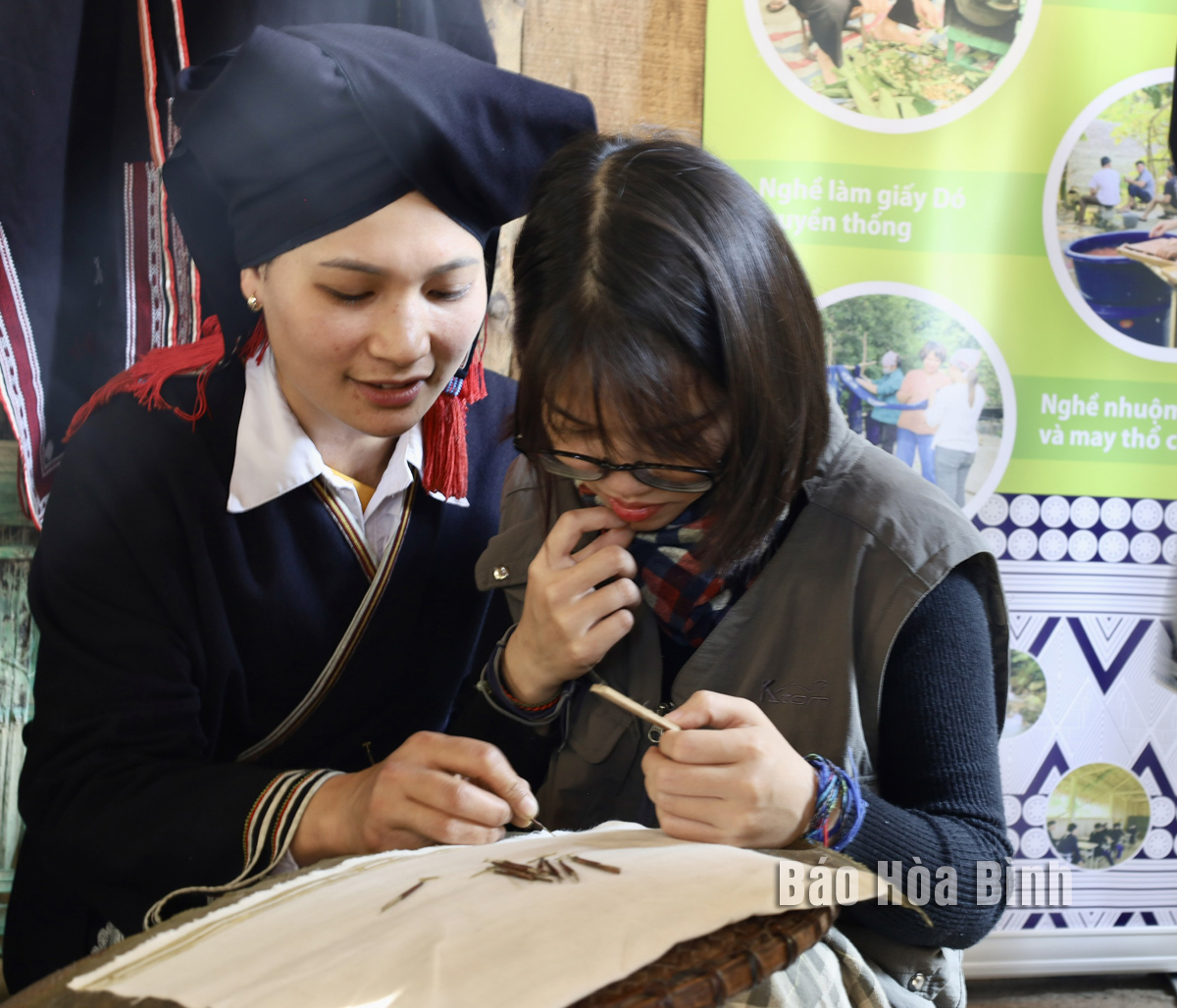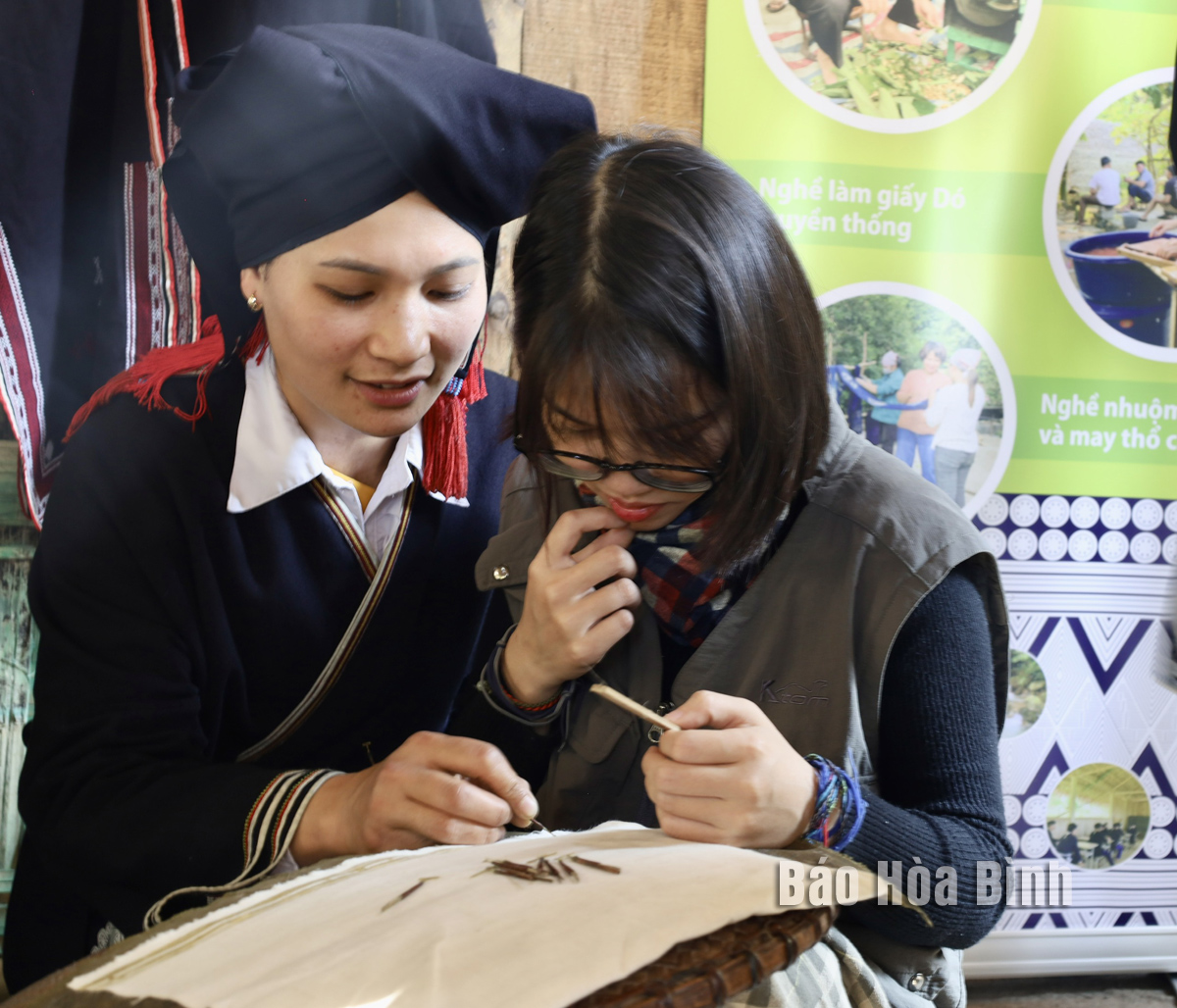
Until now, Sung village in Cao Son commune, Da Bac district remains the only Dao ethnic community in Hoa Binh province to develop a community-based tourism model. Beyond its untouched natural landscapes, cultural identity serves as the cornerstone attraction for visitors.
A visitor experiences the art of beeswax printing on brocade textiles with residents of Sung village, Cao Son commune, Da Bac district.
Traditional houses with thatched palm roofs remain popular in Sung village. Residents maintain their custom of living in ground-level homes built close together, without interior partitions, fostering family togetherness. The traditional architecture has been incorporated in the construction of local lodging facilities.
Local residents have woven fabric and made their traditional clothing that embodies the ethnic minority group’s cultural traits. They said what makes Dao Tien attire distinctive are the silver coin embellishments and intricate patterns combining beeswax printing techniques with tailoring, embroidery, and indigo dyeing.
Over the recent past, the local brocade weaving has been given due attention. Local authorities and non-governmental organisations have supported its revival, developing a brocade weaving group with 11 female villagers. This craft has become a compelling tourism product, drawing visitors to experience such activities as indigo dyeing and beeswax painting. Beyond traditional garments and scarves, the weaving cooperative now produces diverse items including tablecloths, handbags, and wallets to meet tourist demand.
Also thanks to the community-based tourism model, other traditional crafts like herbal medicine and do papermaking continue to thrive while cultural elements such as Dao language classes, medicinal herb collecting, and herbal baths have become attractive tourism products.
Alongside raising awareness about cultural preservation, local livelihoods have steadily improved. Today, over 80% of households in the village generate income through participation in accommodation services, food and beverage, tour guiding, cultural performances, and many more.
Le Thu Phuong, a tourist from Hanoi, said she has been impressed by a peaceful Dao ethnic village along Hoa Binh Lake. During her stay, she visited a medicinal production workshop with its closed-loop production system and solar-powered herb dryer, and engaged in beeswax printing, indigo dyeing, and papermaking alongside local residents
Dinh Thi Hao, Director of Da Bac Community Tourism joint Stock Company, noted that Sung village has been a distinctive destination as it is able to capitalise on local cultural values.
Community-based tourism has been thriving in Pa Co commune, Mai Chau district thanks to advantages in natural landscape and cultural identity.
Doan Ket commune of Yen Thuy district has recently held a ceremony to receive a certificate recognising Ta communal house as a provincial-level historical and cultural relic site.
In Lac Thuy district, the fertile alluvial land along the Boi River is now home to lush green mulberry gardens, marking the emergence of a new agricultural industry - mulberry cultivation and silkworm farming.
Officially opening in February, Ngoi Hoa Ecotourism Site (PriorBay Resort) in Suoi Hoa commune, Tan Lac district, has quickly become a sought-after destination. It offers visitors a chance to indulge in distinctive and enticing experiences.
Gia Trang Heian Homestay, a unique cultural oasis in the heart of Hoa Binh city, has become a compelling attraction for tourists seeking ethnic cultural experiences within an urban setting. Bui Thi Hien, a local in Kim Boi district with aspiration for ethnic culture and community-based tourism development, created the homestay that seamlessly blends traditional and contemporary features.
To make tourism a key economic sector, Da Bac district has focused on investing in infrastructure, diversifying tourism products, and enhancing promotion efforts to create breakthroughs in developing the smokeless industry.



